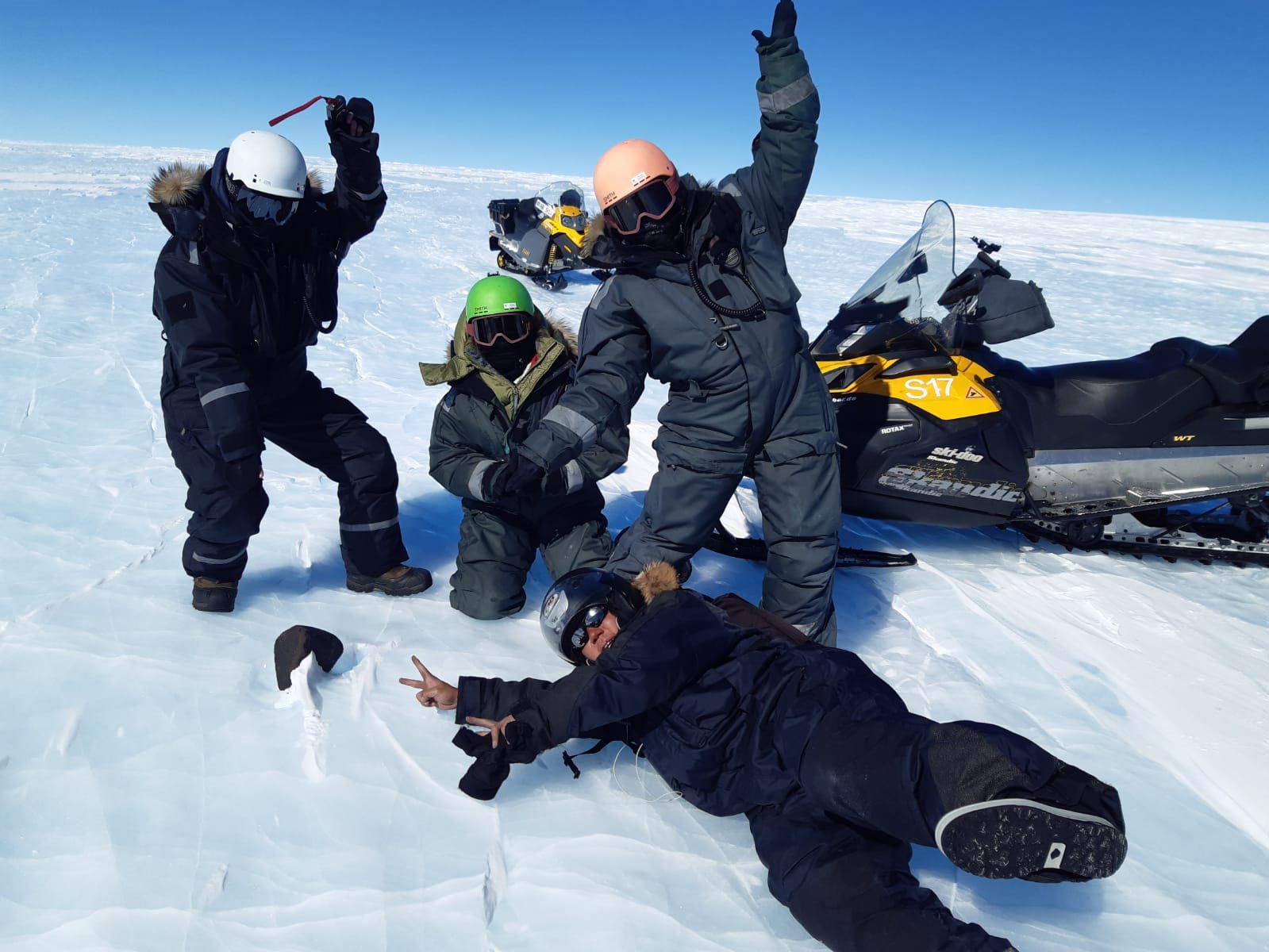
Die Forscher mit ihrem Fund von 16,7 Pfund. Weißhelm: Maria Schönbächler. Grüner Helm: Maria Valdes. Schwarzer Helm: Ryoga Maeda. Oranger Helm: Vinciane Debaille. Bildnachweis: Foto mit freundlicher Genehmigung von Maria Valdes
Die Antarktis ist aus offensichtlichen Gründen ein harter Ort zum Arbeiten: Es ist bitterkalt, abgelegen und wild. Es ist jedoch einer der besten Orte der Welt, um nach Meteoriten zu suchen. Das liegt zum Teil daran, dass die Antarktis eine Wüste ist und ihr trockenes Klima die Verwitterung der Meteoriten begrenzt. Neben den trockenen Bedingungen ist die Landschaft ideal für die Meteoritenjagd: Die schwarzen Weltraumfelsen heben sich deutlich von schneebedeckten Feldern ab. Selbst wenn Meteoriten im Eis versinken, hilft die Wirbelbewegung der Gletscher gegen den Felsen darunter, die Meteoriten nahe der Oberfläche der blauen Eisfelder des Kontinents wieder freizulegen.
Ein internationales Forscherteam, das gerade aus der Antarktis zurückgekehrt ist, kann die Freundlichkeit des Kontinents für Meteoritenjäger bestätigen: Sie kehrten mit fünf neuen Meteoriten zurück, darunter einer, der 7,6 kg wiegt.
Maria Valdes, wissenschaftliche Mitarbeiterin am Field Museum and the[{“ attribute=““>University of Chicago, estimates that of the roughly 45,000 meteorites retrieved from Antarctica over the past century, only about a hundred or so are this size or larger. “Size doesn’t necessarily matter when it comes to meteorites, and even tiny micrometeorites can be incredibly scientifically valuable,” says Valdes, “but of course, finding a big meteorite like this one is rare, and really exciting.”
Valdes was one of four scientists on the mission, led by Vinciane Debaille of the Université Libre de Bruxelles (FNRS-ULB); the research team was rounded out by Maria Schönbächler (ETH-Zurich) and Ryoga Maeda (VUB-ULB). The researchers were the first to explore potential new meteorite sites mapped using satellite imagery by Veronica Tollenaar, a thesis student in glaciology at the ULB.

Rocks strewn across an ice field, with the scientists searching for meteorites in the background. Credit: Courtesy of Maria Valdes
“Going on an adventure exploring unknown areas is exciting,” says Debaille, “but we also had to deal with the fact that the reality on the ground is much more difficult than the beauty of satellite images.” Despite timing their trip for Antarctica’s summertime in late December, temperatures hovered around 14° F (-10° C). Valdes notes that some days during their trip, it was actually colder in Chicago than it was in Antarctica, but spending days riding snowmobiles and trekking through ice fields and then sleeping in a tent made the Antarctic weather feel more extreme.
The five meteorites recovered by the team will be analyzed at the Royal Belgian Institute of Natural Sciences; meanwhile, sediment potentially containing tiny micrometeorites was divided among the researchers for study at their institutions.
Valdes says she’s eager to see what the analyses of the meteorites reveal, because “studying meteorites helps us better understand our place in the universe. The bigger a sample size we have of meteorites, the better we can understand our Solar System, and the better we can understand ourselves.”
The team was guided by Manu Poudelet of the International Polar Guide Association and assisted by Alain Hubert. They were supported in part by the Belgian Science Policy. Valdes’s work is supported by the Field Museum’s Robert A. Pritzker Center for Meteoritics and Polar Studies, the TAWANI Foundation, and the Meeker family.






